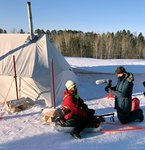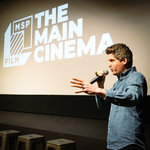















Why do people do this?
Documentary filmmaker Marius Anderson tries to answer this question about the reasons people choose to expose themselves to bitter Minnesota wind and temperatures in the annual Arrowhead 135 winter ultra race that begins in International Falls, one of the coldest spots in the United States.
The participants can race by foot, on bicycle or on skis to cover the 135 miles of trail that covers the northern Minnesota landscape.
Anderson was born and raised in Germany and met his wife in Sweden while running a half marathon. She was from Duluth, and eventually the couple married and Anderson joined her in Duluth in 2017. He has his own film company, London Road, worked as director of photography on documentaries, and co-directed a film called “Iron Opera,” about an opera performance in the Iron Range of Minnesota. He said he was keeping his eyes and ears open, looking for a documentary he would direct on his own.
“One day my father-in-law told me that some of his colleagues took part in this tough race that lasted 60 hours and was done during the most brutal weather,” he recalled. The object was to win the race, but just finishing it was a badge of honor.
“We filmed this in 2019, during a Polar Vortex, so it was even colder,” Anderson said.
“Filming this was very tough for a crew,” he said. “I had a good network of people I worked with, but when I mentioned filming this during the Polar Vortex, everyone seemed very busy. We started filming the last Monday in January in 2019, and I had two small crews. Most of it I filmed myself.”
Anderson researched to find filming equipment that would work in the frigid temperatures. He said the film crew paralleled the athletes. “Some racers do this with no sleep, especially if it is very cold. If you stop, you could become hypothermic, and it could be hours before someone comes by.”
He and his crew got by with very little sleep. “I rented a small cabin at Checkpoint Two, and we slept two to three hours. Everything was a kind of blur. You forget everything around you,” Anderson explained.
Anderson said it was nearly impossible to plan a shoot like this one. “You never know who is going to drop out of the race, or when,” he acknowledged. He said one of the things he finds fascinating about this race is how mentally challenging it can be. One of the racers commented, “When you get into that hurt cave, you have to make a decision to continue or quit.”
Since only 180 racers are allowed to participate, there is space for quite a bit of solitude along the trail. And at night, with the wind howling and the temperatures dropping, a participant can feel very alone.
When he first decided to do the documentary, Anderson got ahold of Ken Krueger, the race director. “He suggested I do the race before I film it, but I told him ‘Maybe someday, but not this year.’” He invited me to film, and I interviewed him before the race.
“He told me that one of the main mistakes racers make is that they sometimes quit before they have to,” Anderson said. There are only three checkpoints in this race, whereas many marathons and other competitions can have as many as 28. Most of those who do quit do so at the second checkpoint.
Anderson told Krueger he would like to focus on a couple of racers for the film, and Krueger immediately suggested Bill Bradley, a competitor from California who was making his eighth try. The other person Anderson followed was Leah Gruhn. She and her husband, both scientists, participated by bicycle. Bradley raced by foot.
On camera, Bradley talks about some of the trials he has endured in his life. He lost his business and his wife, and he eventually started running marathons. As tough and grueling as they were, he considered them nothing compared to what he had gone through. So he has participated in extreme competitions all around the world, including races in the desert with temperatures of 135 degrees Fahrenheit. But he has not been able to finish the Arrowhead 135.
Gruhn and her husband prepare for the race very methodically, carefully weighing out the food they will need. She is going with junk food, because that is what she likes. She has previously attempted the race on foot but has now chosen the fat-tired bike as her choice of movement.
Anderson said he has talked to some bikers who told him they would never consider doing the race on foot. As for the skiers, in some races none of them finish. Overall, about a third of the competitors finish the race.
“Everyone knows the half marathons, marathons and Iron Man competitions are a big thing, and I have the greatest respect for those competitors. But I don’t know if the Iron Man winners could qualify for this race,” Anderson said. “At those competitions, you can collapse anywhere. Somebody will grab you, and the paramedics are there. Nothing can happen. But this race is completely different. It’s very dangerous if you stop moving. The loneliness must be the toughest part to me.”
Bradley added a lot to “40 Below,” according to Anderson. “He allowed me into his world a little bit. I just think everything in life is about winning, but there are more interesting things than who is the fastest or who the big winner is. To me, Bill is motivating. Quite often, when I have to be up at 3 a.m. for a shoot or a flight, I think ‘What would Bill do?’ Bill would never quit.”
For this film, Anderson did 60 hours of interviewing. He interviewed Krueger, Bradley and Gruhn before the race. He flew out twice to California to interview Bradley.
Throughout making the documentary, Anderson said he returned over and over to that question of why people do this. “And I found it is different for everyone,” he stated. “Some come back year after year, and treat it as a family reunion. Someone like Bill has a very different reason. And the reasons are all interesting.”
One racer’s answer as to why he does it was simple. “It separates you from being normal,” he said.
Anderson said he loves to watch documentaries, as well as make them. “The stories are true, and you see the real people. If I saw ‘40 Below’ at a festival, and I had nothing to do with making it, it would still touch me deeply knowing these are real people. I always try to be that fly on the wall, not staging anything or re-creating or directing.
“It is very difficult oftentimes because people might act differently. My approach is to have a small film crew, sometimes just myself. There were so many moments when people forgot about me being there on this film, and that was great,” said Anderson. “They had to stay in the race and keep going.”
For further information about the film, click on www.40belowmovie.com.
View tickets for the MSP International Film Festival running April 13-27 here.
Comments
No comments on this item Please log in to comment by clicking here